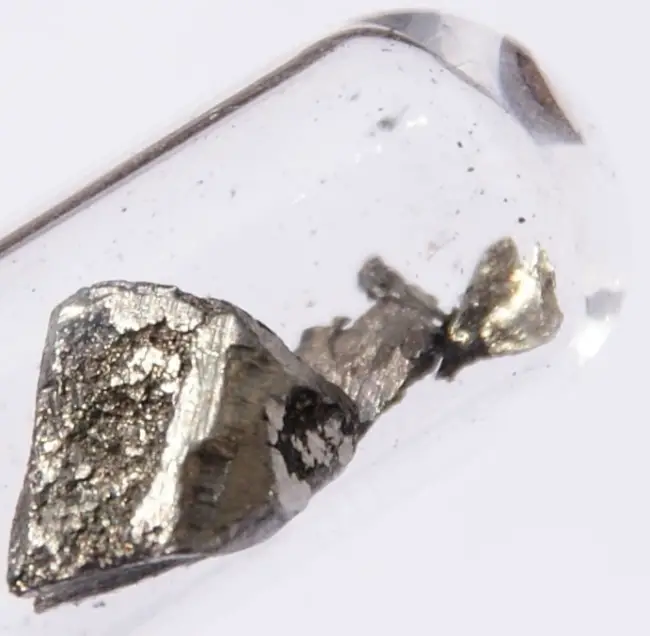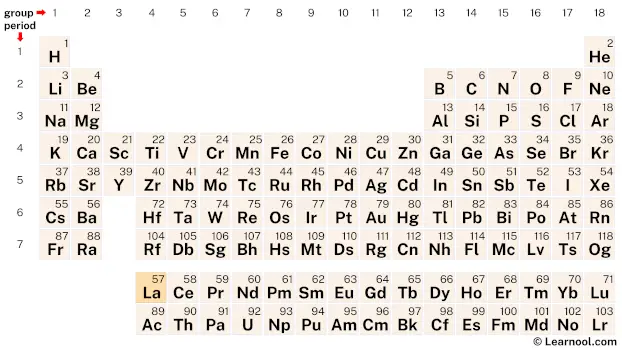
Lanthanum (La) is a chemical element of the periodic table, located in the period 6, and has the atomic number 57. It is the first element in the lanthanide series. It is a soft, silvery-white metal, whose name comes from the Greek word “lanthanein”, which means to lie hidden. It is a highly reactive metal and is counted as one of the rare earth elements.
On periodic table
| group | ⇨ | 1 | 2 | 3 | 4 | 5 | 6 | 7 | 8 | 9 | 10 | 11 | 12 | 13 | 14 | 15 | 16 | 17 | 18 |
| period | ⇩ | ||||||||||||||||||
| 1 | 1 H  Hydrogen |
2 He  Helium |
|||||||||||||||||
| 2 | 3 Li  Lithium |
4 Be  Beryllium |
5 B  Boron |
6 C  Carbon |
7 N  Nitrogen |
8 O  Oxygen |
9 F  Fluorine |
10 Ne  Neon |
|||||||||||
| 3 | 11 Na  Sodium |
12 Mg  Magnesium |
13 Al  Aluminium |
14 Si Silicon |
15 P  Phosphorus |
16 S  Sulfur |
17 Cl  Chlorine |
18 Ar  Argon |
|||||||||||
| 4 | 19 K  Potassium |
20 Ca  Calcium |
21 Sc  Scandium |
22 Ti  Titanium |
23 V  Vanadium |
24 Cr  Chromium |
25 Mn  Manganese |
26 Fe  Iron |
27 Co  Cobalt |
28 Ni  Nickel |
29 Cu  Copper |
30 Zn  Zinc |
31 Ga  Gallium |
32 Ge  Germanium |
33 As  Arsenic |
34 Se  Selenium |
35 Br  Bromine |
36 Kr  Krypton |
|
| 5 | 37 Rb  Rubidium |
38 Sr  Strontium |
39 Y  Yttrium |
40 Zr  Zirconium |
41 Nb  Niobium |
42 Mo  Molybdenum |
43 Tc  Technetium |
44 Ru  Ruthenium |
45 Rh  Rhodium |
46 Pd  Palladium |
47 Ag  Silver |
48 Cd  Cadmium |
49 In  Indium |
50 Sn  Tin |
51 Sb  Antimony |
52 Te  Tellurium |
53 I  Iodine |
54 Xe  Xenon |
|
| 6 | 55 Cs  Caesium |
56 Ba  Barium |
72 Hf  Hafnium |
73 Ta  Tantalum |
74 W  Tungsten |
75 Re  Rhenium |
76 Os  Osmium |
77 Ir  Iridium |
78 Pt  Platinum |
79 Au  Gold |
80 Hg  Mercury |
81 Tl  Thallium |
82 Pb  Lead |
83 Bi  Bismuth |
84 Po  Polonium |
85 At  Astatine |
86 Rn  Radon |
||
| 7 | 87 Fr  Francium |
88 Ra  Radium |
104 Rf  Rutherfordium |
105 Db  Dubnium |
106 Sg  Seaborgium |
107 Bh  Bohrium |
108 Hs  Hassium |
109 Mt  Meitnerium |
110 Ds  Darmstadtium |
111 Rg  Roentgenium |
112 Cn  Copernicium |
113 Nh  Nihonium |
114 Fl  Flerovium |
115 Mc  Moscovium |
116 Lv  Livermorium |
117 Ts  Tennessine |
118 Og  Oganesson |
||
| 57 La Lanthanum |
58 Ce  Cerium |
59 Pr  Praseodymium |
60 Nd  Neodymium |
61 Pm  Promethium |
62 Sm  Samarium |
63 Eu  Europium |
64 Gd  Gadolinium |
65 Tb  Terbium |
66 Dy  Dysprosium |
67 Ho  Holmium |
68 Er  Erbium |
69 Tm  Thulium |
70 Yb  Ytterbium |
71 Lu  Lutetium |
|||||
| 89 Ac  Actinium |
90 Th  Thorium |
91 Pa  Protactinium |
92 U  Uranium |
93 Np  Neptunium |
94 Pu  Plutonium |
95 Am  Americium |
96 Cm  Curium |
97 Bk  Berkelium |
98 Cf  Californium |
99 Es  Einsteinium |
100 Fm  Fermium |
101 Md  Mendelevium |
102 No  Nobelium |
103 Lr  Lawrencium |
|||||
| – f block |
Lanthanum (La) is located on the periodic table in the lanthanide series, which is a group of elements located at the bottom of the table. Specifically, in period 6, next to barium (Ba).
Element information
 |
|
 |
|
| Origin of name | Greek word “lanthanein” (which means to lie hidden) |
| Symbol | La |
| Atomic number (Z) | 57 |
| Atomic mass | 138.90547 u |
| Block | f-block |
| Period | 6 |
| Classification | Lanthanide |
| Atomic radius | 187 pm |
| Covalent radius | 207±8 pm |
| Melting point | 920 ℃, 1688 ℉, 1193 K |
| Boiling point | 3464 ℃, 6267 ℉, 3737 K |
| Electron configuration | [Xe] 5d1 6s2 |
| Electrons per shell | 2, 8, 18, 18, 9, 2 |
| Crystal structure | Double hexagonal close-packed (dhcp) |
| Phase at r.t | Solid |
| Density near r.t | 6.162 g/cm3 |
| Main isotopes | Lanthanum-139 |
| Natural occurrence | Primordial |
| Oxidation state | +3 |
| Electronegativity (Pauling scale) | 1.10 |
| Protons Neutrons Electrons |
57 82 57 |
| CAS number | 7439-91-0 |
| Discovered by | Carl Gustaf Mosander in 1839 |
History

Lanthanum is a member of the lanthanide series and is named after the Greek word for “to lie hidden.” Lanthanum was first discovered in 1839 by the Swedish chemist Carl Gustaf Mosander, who extracted it from cerium nitrate.
Mosander was studying the mineral cerite, which had been discovered earlier in Sweden. He found that cerite contained several different rare earth elements, including lanthanum oxide. Mosander was able to isolate lanthanum oxide by treating cerite with nitric acid and then precipitating the lanthanum with oxalic acid.
After its discovery, lanthanum remained a relatively obscure element until the late 19th century, when chemists began to explore the properties of the rare earth elements more thoroughly. In the early 20th century, lanthanum found use in the manufacture of gas lantern mantles and was also used in the production of ferrocerium, a material used to create sparks in lighters and other devices.
Today, lanthanum is still used in the production of ferrocerium, as well as in the manufacture of nickel-metal hydride batteries, which are used in hybrid and electric vehicles. It is also used in the production of high-refractive-index glass, such as the lenses used in cameras and telescopes.
Occurrence and production
Lanthanum is a relatively abundant element, ranking as the 28th most abundant element in the Earth’s crust. It is found in a number of minerals, including monazite and bastnasite. Monazite is the most common source of lanthanum, and is primarily found in India, Brazil, and South Africa. Bastnasite, on the other hand, is found mainly in the United States, China, and Australia.
The production of lanthanum involves the extraction of lanthanum-containing minerals, which are then processed to obtain pure lanthanum metal. The primary method of extraction is through solvent extraction, where the mineral concentrate is dissolved in acid and then treated with organic solvents to separate the lanthanum from other rare earth metals. The resulting lanthanum compound is then heated with a reducing agent to produce pure lanthanum metal.
Lanthanum is also produced as a byproduct of the extraction of other rare earth elements, such as cerium and neodymium. In this case, the lanthanum is extracted from the waste material produced during the processing of these other elements.
Properties
Lanthanum is a silvery-white, malleable and ductile metal.
It has a relatively low melting point of 920 ℃ and a boiling point of 3464 ℃.
It is highly reactive and can quickly tarnish in air, forming a protective oxide layer that prevents further oxidation.
Lanthanum is paramagnetic, meaning it can be weakly magnetized when exposed to a magnetic field.
Lanthanum is a relatively soft metal and can be easily cut with a knife.
Applications
Lanthanum oxide is an important component of high-performance ceramics used in electronics, communication devices, and thermal barrier coatings.
Lanthanum carbonate is used as a material for the gas lantern mantles because of its ability to emit a bright light when heated.
Lanthanum-nickel-hydride batteries are used in electric vehicles and hybrid cars.
Lanthanum compounds are used as catalysts in the cracking process of petroleum refining.
Lanthanum oxide is used as a component of optical glasses due to its high refractive index.
Small amounts of lanthanum are added to steel to improve its strength and ductility.
Lanthanum-containing contrast agents are used in MRI imaging.
Interesting facts
Lanthanum was named after the Greek word “lanthanein” which means “to lie hidden”, as it is a rare earth metal that is not found in large quantities in the Earth’s crust.
Lanthanum is the first element in the lanthanide series of elements, which includes all the rare earth metals.
Lanthanum is a soft, malleable, and ductile metal that can be easily cut with a knife. It has a silvery-white appearance that tarnishes quickly when exposed to air.
Lanthanum is used in the production of high-intensity carbon arc lamps, which are used for movie projectors and studio lighting. It is also used in other types of lamps, such as incandescent lamps and fluorescent lamps.
Lanthanum is added to steel and iron to improve their strength, hardness, and ductility. It is also used in other alloys, such as nickel-metal hydride batteries, which are used in hybrid vehicles and other applications.
Lanthanum is a component of catalysts used in the refining of crude oil and in the production of gasoline. It is also used as a catalyst in the production of plastics and synthetic fibers.
Lanthanum has no known biological role and is considered to be toxic to humans and other animals.
Related
More elements
External links
- https://www.rsc.org/periodic-table/element/57/lanthanum
- https://en.wikipedia.org/wiki/Lanthanum
- https://www.britannica.com/science/lanthanum
- https://pubchem.ncbi.nlm.nih.gov/element/Lanthanum
- https://www.chemicool.com/elements/lanthanum.html
- https://study.com/learn/lesson/lanthanum-element-facts-uses.html
- https://www.livescience.com/37604-lanthanum.html
- https://www.thoughtco.com/lanthanum-facts-la-element-606550
Deep
Learnool.com was founded by Deep Rana, who is a mechanical engineer by profession and a blogger by passion. He has a good conceptual knowledge on different educational topics and he provides the same on this website. He loves to learn something new everyday and believes that the best utilization of free time is developing a new skill.
